
Wine Culture and Information since 2002 - Volume 22
 Wine Culture and Information since 2002 - Volume 22 |
|
Issue 37, January 2006 |
Contents |
|
|
Wine and Health |
|
In Italy it is often said red wine makes good blood. This is just one of the most famous Italian proverbs about the effects of wine on health, not the only one, of course, concerning the beverage of Bacchus in relation to the many aspects of human's life. Of course, we are not doctors and we certainly have not the right experience or any conceit to give our readers indications on these subjects, as it is always appropriate to ask a qualified specialist. Anyway, it seems to be strange and improbable the fermented juice of red grapes has the capability - after its ingestion - to transform itself into blood, as suggested by the famous proverb. It is very likely this proverb is not to be considered “literally” and it is also true the term “blood” gets different meanings according to the contest in which it is being used, frequently used as a synonym of courage, mood as well as of life. Capability of making “good blood” apart, it is obvious wine however has some effects on human body, including any “side” effect caused by alcohol. Concerning these subjects, at least, it is not necessary to be a doctor in order to understand the effects of alcoholic beverages, something which is hardly agreeable. Anyway, wine is not alcohol only and its more than 250 elements of which it is made of, have other effects on human body. According to a nutritional of view, the contribution of nutritive elements contained in wine is rather negligible, as the most important nutritive principles are contained in traces only. Therefore, the nutritional value depends on the quantity of energy ethyl alcohol is able to provide, about 7 calories per gram, including the ones provided by any sugar contained in the wine. However, it is necessary to remind the contribution of alcohol's calories is not directly usable from the body for the muscular work, they are used by basal metabolism, allowing a saving in the consumption of other nutritive values, such as fats and sugars. According to a nutritional point of view, it is necessary to consider the calories of alcoholic beverages and of wines in the total count of calories ingested, while remembering calories provided by alcohol are not very efficient for the body. For example, a gram of alcohol provides 7.3 calories (each unit of alcoholic volume corresponds to 7,9 grams), a gram of sugar provides 4.1 calories, a gram of fat corresponds to 9.3 calories and a gram of protein to 4.4 calories. A gram of alcohol has more calories than sugar and proteins, and a little less than fats. To calculate the calories alcohol contained in a beverage can provide, it is enough to multiply the alcohol by volume in a liter times 7.9 (the weight in grams of an unit of alcohol volume) then times 7.3 (calories provided by each gram). Therefore, a liter of wine with an alcohol by volume of 13% gives about 749 calories. If we consider the volume of a typical glass - about 125 milliliters - each of them provides to the body about 93 calories. It should be noted to this result must be added the calories provided by any sugar contained in wine. Wine is not alcohol only. It is an extremely complex beverage made of more than 250 different elements, and many of them can have positive effects and benefits on the body. Since ancient times, man has always paid special attention to wine, by observing its positive and negative effects. It is more likely, the first effect seen in wine certainly was the one caused by alcohol, which is - as a matter of fact - classified as a toxic substance and, as such, it is always necessary to consume it in moderation, and never abusing of it. The moderate consumption of wine and of alcoholic beverages is always subject of debates, in which folk's wisdom - and the common sense motivated by a responsible and clever consumption - has always recognized as deplorable and the abuse was not encouraged at all, although in past times, certain meetings exclusively reserved to men often ended with participants getting drunk. The folk's wisdom on moderate consumption of wine can be summarized with the Italian proverb “One who drinks a little of wine is a sheep, who drinks it in right quantity is a lion, who abuse of it, is a donkey”, of course paying respect to the intelligence of the animals mentioned in the less noble examples. The use of wine as a remedy or medicine is documented since the beginning of civilization, not only for the effects related to alcohol, but also for the other properties of the beverage of Bacchus for the prevention and cure of some symptoms. For example, it is documented that, in past times, wine produced with grapes affected by Botrytis Cinerea was given - of course to the ones who could afford such expensive wines - for the cure of some diseases. It is probable these wines had a mild antibiotic action - this could justify their beneficial effects - noticed in some cases. Even in many medical and cooking treatises of the past, the beneficial properties of wine for the body and for the prevention of some disorders were extolled, something which corresponded to be true, although not scientifically proven at those times, but certainly proven by empiric methods and by direct observation. Science and modern medicine keep on investigating on wine and on its effects on health. In the last years, there have been many “discoveries” about wine, probably also encouraged by the social interest towards this beverage and - certainly - also by economic interests, as to make wine looking like a panacea. Of course, modern methods and scientific research allowed the discovery of many positive effects which modern medicine is attributing to wine. It seems the humble grape juice after it has being fermented gets almost magic qualities, like an elixir of life and wellness. The doubt there is a sort of exaggeration about this subject is however pretty strong. Wine certainly has good effects on health and body, it can surely have a preventive action against certain disorders, however it is often forgotten its abuse is detrimental. The exaltation of the positive qualities of wine could result in an excessive consumption, even justified, because the higher the quantity, the better the effects. An excessive consumption of wine means an excessive consumption of alcohol and this is something which cannot have positive effects on health. We should remember about that, and the ones who support the good quality of wine should remember that as well, because among the good qualities of wine, there is - and it must be, always and however - moderation. This is a good effect on health, too.
|
||||
MailBox |
|
In this column are published our reader's mail. If you have any comment or any
question or just want to express your opinion about wine, send your letters to
our editorial or fill in
the form available at
our site.
|
| I like very much pairing dry sparkling wines with desserts, although there are many people who remind me this is a wrong combination. Why is it not possible to pair sparkling wines with desserts? |
| Dario Bonutti -- Udine (Italy) |
| Before replying to your letter, we would like to remember - by borrowing the ancient wisdom of those who preceded us - that de gustibus non est disputandum (there is no debate about tastes), so if you like pairing a dry sparkling wine with desserts, no one has the right to object. In suggesting a food match, the criteria are based on technical principles which should be - and conditional tense is always a must - objectively agreed by anybody. This does not mean food pairing represents an unquestionable rule, it should be taken like a suggestion. According to a technical point of view, sweet foods are always paired with a sweet wine in order to favor sweetness in desserts. As opposed to other organoleptic sensations - for which are required wines having elements capable of contrasting them - in sweets, it is best not to contrast sweetness, because it could cause the mutual disharmony of wine and food. Indeed, it is better to emphasize the sweet quality, both because it is coherent with the kind of food, as well as because food and wine can exalt each other this way. |
| I recently discovered grappa and, by browsing the internet, I discovered there are some shops which sell grappa made with rue and fruits. I know grappa comes from the distillation of grape's pomace. How is it possible these kinds of grappa can exist? |
| Catherine Wilson -- San Diego, California (USA) |
| As you have rightly observed, grappa is produced from the distillation of grape's pomace only. According to the Italian law, no other distillate produced with other fermentable matters can be defined as grappa. Fruits can be properly fermented and distilled in order to produce an alcoholic beverage which - in this specific case - is called fruit brandy or fruit distillate. For example, in case a distillate is produced with fermented pears, it can be defined as distillate of pears or pear brandy only, never - and in any case - it ca be called grappa of pear. Anyway, grappa - the product which comes from the distillation of the grape's pomace - can also be aromatized with substances of vegetal origin. In this case, vegetal substances - for example fruit or aromatic herbs - are macerated in grappa in order to extract their organoleptic qualities - which will be added to the ones of grappa - therefore obtaining aromatized grappa. For example, in case pears are being macerated in grappa, it will be obtained grappa of pears, not to be confused in any case with a pear brandy. |
BaroloNotoriously defined as “the king of wines, the wine of kings”, Barolo is today among the best expressions of Italian enology, a robust and complex wine, majestic expression of Nebbiolo grape |
|
Who could ever imagine the past of the majestic Barolo was very distant from the splendor of our times and that until the 1800's it was even a sweet wine? Probably few, if not very few. Nevertheless the history of this great wine - majestic expression of the noble Nebbiolo grape - is rather recent, a monument to the worldwide enology, born and grown thanks to the application of right methods. Today, Barolo is everywhere synonym of enological excellence, a wine which occupies - with merit - the highest prestigious positions in each country of the world, a strong and complex wine, capable of surprising the palates of the most exigent tasters. Among the many factors which are responsible for the magic called Barolo, a special place is occupied by the grape with which it is produced: Nebbiolo. This grape is rich in polyphenols, capable of ensuring a full body to the wine, as well as a generous acidity, a quality which permits Barolo to be a unique wine among the greatest ones, and which together allow longevity for decades of years. Barolo is not Nebbiolo only. Despite this grape variety is largely responsible for the quality of this great wine, Barolo is also - and especially - the result of absolutely unique environmental, climate and productive conditions. Barolo is one of Langhe's many sons, the famous area in the southern part of Piedmont - in the nearby of Alba, in the province of Cuneo - whose lands gave origin to great wines and excellent food delicacies, such as white truffles. Barolo is among the most long-lived wines: thanks to the quality of Nebbiolo grape - acidity and tannins - together with the high alcohol volume, this wine is capable of aging and evolving in bottle for decades of years, while improving its organoleptic qualities and the complexity of its flavors. For wine enthusiasts - as well as for the producers - Barolo is the subject of heated debates: some love it and some do not appreciate it, some want to produce it by using traditional methods, some want to interpret it by following the most modern vision instead.
Barolo has always been a very famous wine, also when it was practically unknown and very far from the image of a great wine to which we are used today. The first historical documents related to Barolo referred not to the wine but to the grape with which it is produced: Nebbiolo. The first document about this grape variety date back to 1268, in a document of Rivoli castle, in which Nebbiolo is mentioned. The first document about wines produced with this kind of grape is dated back to medieval times. Barolo's history - which takes its name from the homonymous town of Langhe - that is the dry wine as we know it today, begins in the first years of 1800. Before those times, Barolo's wine was characterized by a sweet taste caused by the presence of residual sugars, which - because of the effect of low temperature typical in those places - could not completely get fermented. Temperature was not the only responsible for this problem. Nebbiolo is a late ripening variety - usually at the end of October - when Langhe's temperature begins to go down therefore inhibiting the work of yeasts. At those times, Barolo wine was very far from the greatness which we recognize to it today, on the tables of nobles and of the richest classes were mainly served French wines. Barolo wine produced at those times was consumed locally - often exported, too - but no one recognized to it the nobility which will give it celebrity a century later. The development of Barolo wine making is the result of the commitment of Giulia Vittorina Colbert de Maulévrier - born in June 26th, 1786 in Maulévrier Castle, in Vandée, France - who in 1806 married marquis Carlo Tancredi Falletti of Barolo in Paris, therefore becoming the famous marquise Falletti of Barolo. Notable figure, she moved to Turin and dedicated her life to the improvement of social conditions of the poor and sick people, she was interested in jailed women's conditions, she founded educational and relief institutes, a hospital for children and organizations for the rehabilitation, education and maintenance of needy people. At those times, the charm of French wines - and particularly those from Bordeaux and Burgundy - was so prestigious that in many areas they tried to imitate this model in order to improve the quality of local wines, a trend which continues even today. In 1843, count Camillo Benso of Cavour - at that time mayor of Grinzane - called to his estates the French enologist count Louis Oudart, assigning to him the job of making wines in Grinzane's cellars. Thanks to the friendship with count Cavour, marquise Falletti of Barolo asked the French enologist for advice on how improving the wines in her cellar, hoping to make them similar to French wines. Louis Oudart realized low temperature was the cause which produced sweetness in Barolo, then he suggested the use of specific yeasts: the great Barolo was about to born. As a consequence, marquise Falletti of Barolo decided to completely change the production systems of her wines, adopting the ones suggested by Oudart, introducing French enological technologies, which transformed forever Barolo from a sweet wine to a great dry wine, “the king of wines, the wine of kings”. The history was changed and this time forever. It was a striking success and also count Cavour decided to convert the cellars of his castle to the production of this “new wine”. In just a little time, Cavour's wines became famous, as to compete with the best ones produced in France, largely contributing to the improvement and spreading of Barolo. The new Barolo filled with enthusiasm even Carlo Alberto who - being very curious about the success of marquise Falletti of Barolo's wines - asked her to try her wines. The marquise sent 325 Carrà of Barolo - a flat and long barrel typical in those areas with a volume of 500 liters - to the royal palace. Carlo Alberto was so enthusiastic that he decided to buy Verduno Castle, Pollenzo Estates and Santa Vittoria d'Alba, with the goal of planting Nebbiolo vineyards and starting the production of Barolo. Even king Vittorio Emanuele II showed interest and enthusiasm for Barolo, and converted his estates near his hunting lodge in Serralunga d'Alba, to the production of the famous wine with Nebbiolo grapes cultivated in his vineyards. The first spreading of Barolo is credited to Pietro Emilio Abbona, who in 1895 started his business in the cellars of his father, in the town of Barolo. He also acquired the vineyards and the cellars of marquise Falletti of Barolo, ideally continuing her work for this famous wine. A notable figure for the development and qualitative improvement of Barolo was Renato Ratti. Besides introducing revolutionary concepts and new technologies in Barolo production, he did meticulous researches on the territory, on the vineyards and on the crus, a study which will permit to him - in 1980's - to create a map of the historical areas of Barolo and Barbaresco. Barolo production has developed in recent times thanks to the commitment of many producers, often with different - if not opposite - way of interpreting the great wine of Langhe. Most of them, in fact, support the production by using traditional methods of aging in casks, others instead see Barolo produced with the most modern enological methods by using the barrique. A debate which sees traditionalists and modernists in two opposite sides, two different ways of interpreting Barolo, also having supporters and opponents among consumers.
|
||||||||||||
|
Barolo is classified according to the Italian quality system as DOCG (Denominazione d'Origine Controllata e Garantita, Denomination of Controlled and Guaranteed Origin), recognized in 1980. The production area of Barolo was delimited for the first time in 1908, as a consequence of the success obtained in Europe and therefore was necessary to protect both the area and the wine. In 1934 was founded the “Consorzio di Tutela del Barolo e del Barbaresco” (Consortium for the safeguarding of Barolo and Barbaresco) and in 1966 Barolo was recognized as DOC (Denominazione d'Origine Controllata, Denomination of Controlled Origin). According to the production disciplinary, Barolo must be exclusively produced with Nebbiolo Michet, Lampia or Rosè varieties, in the whole territory in the communes of Barolo, Castiglione Falletto and Serralunga d'Alba and in part of the territories in the communes of Cherasco, Diano d'Alba, Grinzane Cavour, La Morra, Monforte d'Alba, Novello, Roddi and Verduno. The maximum allowed production per hectare is 80 quintals, equal to 52 hectoliters of wine. Barolo must age for at least 3 years, of which at least 2 in chestnut or oak cask, starting from January 1st following the harvesting of grapes. The minimum alcohol by volume for Barolo is 13%, an useful characteristic for the balance of this wine, as Nebbiolo is rich in polyphenols and makes wines with an appreciable acidity. For this reason, it is pretty frequent to find a Barolo with an alcohol by volumes higher than 14%. Barolo, aged for a at least 5 years in cellar, can be classified as riserva (reserve). Despite the most distinctive production areas are Barolo, La Morra, Castiglione Falletto, Serralunga d'Alba and Monforte d'Alba, the disciplinary does not allow the mention of the commune or the subarea of origin in the label, however it is frequently found the cru of origin.
|
|
Barolo is a very famous wine. Rich, complex and capable of long aging - often decades of years - Barolo is not a wine for absent-minded people. Barolo - the good one - always asks for complete attention in each phase of the evaluation. Behind this great wine there is Nebbiolo grape, rich in polyphenols and with a good acidity, capable of giving Barolo - as well as all the other wines produced with this grape - a robust body and crispness, something which has to be properly balanced by a proper quantity of alcohol. Although Barolo can be produced in part of the territories in the communes of Verduno, Grinzane Cavour, Diano d'Alba, Roddi, Cherasco and Novello, 87% of the production comes from the communes of Barolo, Castiglione Falletto, La Morra, Serralunga d'Alba and Monforte d'Alba. The type of soil - together with climate conditions of the territories - largely determine Barolo style, its longevity and its organoleptic qualities. The territories of Barolo and La Morra are characterized by limestone and fertile soils, give rounder wines, with strong fruit flavors, garnet red color with ruby red nuances and which age rapidly. The territories of Monforte d'Alba, Castiglione Falletto and Serralunga d'Alba are characterized by sands and less fertile soils, giving intense wines with a fuller body, a garnet red color with brick red nuances, aging more slowly. The classification of the vineyards and the subareas of Barolo was done by Renato Ratti, who in 1980 - after having researched historical and territorial elements - created the map of crus, an essential reference for every enthusiast of this great wine from Langhe. Among the most famous crus are mentioned: Cannubi, Sarmazza and Brunate, in the commune of Barolo; Rocche, Cerequio and Brunate (shared with the commune of Barolo) in the territories of La Morra; Rocche, Villero and Monprivato in Castiglione Falletto; Lazzarito and Vigna Rionda in Serralunga d'Alba; Bussia, Ginestra and Santo Stefano di Perno in Monforte d'Alba. Barolo has always been distinguished for its full body, of which are responsible the tannins of Nebbiolo grape. This characteristic forces producers to a scrupulous vinification procedure, because an excessive extraction of polyphenols, as well as an excessive aging in cask, can cause wines to be very tannic with a bitter taste. The use of casks and the duration of aging gave origin to the two schools of thought, which are opposed one to each other since many years: traditionalists who support long period of maceration and aging in casks; modernists who support instead a shorter maceration and aging in barrique. Traditionalists and modernists apart, Barolo is an unique wine in its style, with a full body, crisp and alcoholic, however and always amazing for its complex flavors, result of the patient work of time. In the heated debate between modernists and traditionalists, Barolo is always and in any case the winner, as in both cases there are wines capable of confirming the ideas and the excellence of both parts. Barolo is always a surprise, even in this aspect.
|
Three Ways of Being ChardonnayThe most famous white berried grape of the world, virtually found in every area in which wine it is being produced, it is the protagonist of this month's comparative tasting |
|
Chardonnay probably is the most famous name in the world of wine and also neophytes - as well as the one who are not interested in wine - have heard about it at least once. Frequently considered as a “magic word”, capable of transforming even the most mediocre wine into a divine nectar, Chardonnay is among the most common and renowned grapes in the world. Protagonist of countless white and sparkling wines, in which it is being used alone, Chardonnay is also a companion of other grapes, most of the times used to give specific organoleptic qualities, even more frequently to obtain an easier commercial success. Coming from Bourgogne, Chardonnay has rapidly become successful worldwide thanks to the excellent French wines - in particular Chablis and Champagne - therefore becoming synonym of unquestionable quality. It is superfluous to remember - and this is certainly true for every other grape - Chardonnay is not enough to make a good wine. This is clearly proven by the high number of wines produced with this grapes, most of the times being mediocre and lacking any good quality. Luckily, not all the Chardonnay is cultivated and vinified with speculative and trendy logics: in wines produced with quality principles, the results are excellent and extraordinary. According to an enological point of view, Chardonnay is a very versatile grape, it can be successfully vinified both with the aging in inert containers - such as stainless steel - as well as in wood containers, in particular, the barrique. Thanks to its organoleptic qualities, Chardonnay is also used together with other varieties, while giving the wines in which it is present, an unmistakable touch of immediacy and smoothness. Moreover, the versatility and the organoleptic qualities of Chardonnay make this grape particularly suited to the production of classic method sparkling wines, most of the times used alone. Also thanks to these qualities, Chardonnay has easily conquered the scene in the vineyards worldwide, while offering to producers and consumers the illusion of having a great wine even in pretty modest conditions.
|
|
The goal of our tasting is to compare three different styles of Chardonnay, produced in different areas and - in particular - by using three different wine making techniques. Thanks to its versatility in the cellar, Chardonnay can be in fact successfully vinified both in stainless steel tanks, as well as in wood barrels - in particular the barrique, a technique, the latter, very common in every wine country of the world. We will also pay attention on typical organoleptic qualities of Chardonnay - in particular on its aromas - and the way they change according to the technique used for vinification. The wines selected for our comparative tasting are produced in three regions of northern Italy with 100% Chardonnay and with three different wine making techniques. We selected a wine completely produced in steel tanks, one completely produced in barrique and - finally - one produced with a mixed technique, that is part of the wine aged in steel tanks and the other part in cask.
The first wine of our comparative tasting is Ascevi Luwa's Rupis Chardonnay, produced in Friuli Venezia Giulia, it is the only wine of the three vinified in steel tanks. The second wine is Tre Monti's Colli di Imola Chardonnay Ciardo, produced by aging only a part of the wine in barrique and the remaining part in steel tanks. The third and last wine is Produttori Colterenzio's Alto Adige Chardonnay Cornell, a full bodied wine fermented and aged in barrique for 11 months. Because of the techniques used for the production, the three wines will be served at different temperatures: 10°C (50°F) for Rupis Chardonnay and Colli di Imola Chardonnay Ciardo, 12°C (54°F) for Alto Adige Chardonnay Cornell in order to favor a better development of aromas both given by the aging in barrique and by time. The tasting will be done by using ISO tasting glasses. Finally, in all the three wines, it will be chosen the most recent vintages available.
|
||||||||
|
Because of the different vinification techniques generally used with Chardonnay, it is pretty hard to give reliable indications about the color of the wines produced with this grape. The main factor determining hue in Chardonnay wines, is frequently represented by the fermentation and aging in cask - rarely in casks, frequently in barrique - a pretty common vinification technique for this grape. Chardonnay wines fermented or aged in barrique usually get colors ranging from straw yellow to golden yellow, whereas in wines produced in steel tanks - or however in inert container - the color shows greenish or straw yellow hues. Even the aging in bottle - just like any other white wine - will contribute to accentuate the color of the wine towards golden yellow hues. In this specific case, it should be remembered the aging in bottle can be done for Chardonnay aged in cask, whereas for wines aged in inert containers, it is best to consume them within two or three years. The first wine we will examine is Ascevi Luwa's Rupis Chardonnay, the only wine of the three completely vinified in steel tanks. By observing the wine at the base of the glass, it will be noticed a brilliant straw yellow color, whereas by tilting the glass on a white surface, it will be observed greenish yellow nuances. Then we will observe Tre Monti's Colli di Imola Chardonnay Ciardo, in which will be noticed a deeper color than the previous wine. It will be observed a pale golden yellow color and greenish yellow nuances, effect of the aging of part of the wine in barrique. Finally, it will be observed the color in Produttori Colterenzio's Alto Adige Chardonnay Cornell: in this wine the color is brilliant golden yellow with golden yellow nuances, result of the fermentation and aging in barrique. By placing the glasses side by side, it will be clearly observed how the color tends to get a deeper hue according to the use of barrique in the production of these wines.
|
|
The wine making techniques used for the production of the three wines will be clearly evident even in the olfactory analysis. Chardonnay usually attracts producers - as well as consumers - for its versatility in the production of wines, as it is capable of producing very good wines, both when vinified in steel tanks, as well as in cask. According to this point of view, Chardonnay is the preferred grapes of those consumers who particularly like white wines aged in cask. The contribution of wood in the olfactory qualities of Chardonnay goes beyond the “simple” aroma of vanilla typical in wines aged in barrique. When properly used, barrique positively contributes to the olfactory qualities of Chardonnay, by adding to the freshness of fruit and flowers aromas, the complexity of toasted aromas. This is what we will try to understand from the olfactory analysis of the three wines of our comparative tasting. We will begin the comparison of aromas from Ascevi Luwa's Rupis Chardonnay. After having poured the wine in the glass - and by keeping it in vertical position without swirling - it will be evaluated opening aromas. This initial smell will reveal aromas of banana, peach and pear: banana - in particular - is a distinctive aroma of Chardonnay. After having swirled the glass, a second smell will be done: the aromatic series will be completed by hints of pineapple, acacia, litchi, broom, plum, apple, hawthorn and - finally - hints of elder. Just like banana, even acacia is a distinctive aroma of Chardonnay. The choice of producing this wine in steel tanks favors the development of Chardonnay's typical aroma, as well as allowing an intact olfactory analysis, without any alteration produced by the barrique. The second wine of which we will evaluate aromas is Tre Monti's Colli di Imola Chardonnay Ciardo. Without moving the glass and by keeping it in vertical position, we will evaluate opening aromas. From the glass can be perceived aromas of pear, acacia and banana, qualities we already found in the previous wine and which are typical in Chardonnay. After having swirled the glass, do a second smell which will allow the perception of aromas of hawthorn, green apple, pineapple, peach, plum and, finally - as a sign of the aging of a part of this wine in barrique - an aroma of vanilla. Let's now evaluate the last wine: Produttori Colterenzio's Alto Adige Chardonnay. The evaluation of the opening aromas will allow the perception of hazelnut, toasted and banana: the contribution of barrique is now clearly evident although allowing the perception of banana, a typical aroma in Chardonnay. The second smell will reveal aromas of acacia, butter, coffee, pineapple, broom, passion fruit, grapefruit, vanilla, plum and praline. Despite the contribution of barrique is evident, it is interesting to notice how the aromas of wood are excellently balanced as well as allowing the full perception of flowers and fruit aromas, in particular tropical fruit, frequent in many Chardonnays.
|
||||
|
Chardonnay is a grape with moderate acidity, capable of making pleasing and round the wines in which it is being used. Moreover, it is well suited for the vinification in cask and - in particular - in barrique, a quality which is usually clearly evident in the gustatory analysis as well. The agreeability of Chardonnay is however ensured even by the vinification in steel tanks, where a proper cultural technique and the correct choice of the harvesting period, allow the creation of crisp and pleasing wines. The aging in barrique - of course - makes Chardonnay wines more structured and round, a quality which is however associated both to time and to the cask's volume and type of toasting. The three wines of our comparative tasting - produced with different techniques - confirm the versatility of Chardonnay and its agreeability. Just like in the previous evaluations, we will begin from Ascevi Luwa's Chardonnay Rupis. The attack of this wine is crisp and agreeable, the correspondence to the nose is very good, and the contribution of alcohol is fundamental in order to have a very good balance, while expressing in the mouth the freshness of the fruits perceived to the nose. The second wine we will examine is Tre Monti's Colli di Imola Chardonnay Ciardo. The attack of this wine is crisp and agreeable, however it should be noticed how structure and smoothness are higher than the previous wine, a sign of the aging in barrique. Even the perception of alcohol is evident, efficiently contributing to the good balance of the wine. Finally, it will be evaluated Produttori Colterenzio's Alto Adige Chardonnay Cornell. Despite it is fermented and aged in barrique, the attack of this wine is characterized by a good crispness. The structure and roundness are higher than the previous wines, a direct effect of the barrique, however correctly used and in order to keep the other organoleptic qualities intact.
|
|
The three wines of our comparative tasting are three excellent examples of Chardonnay's versatility and of the correct application of three different vinification methods. The finish of Ascevi Luwa's Rupis Chardonnay is persistent with clear flavors of peach, plum and litchi as well as hints of banana. Even the finish of Tre Monti's Colli di Imola Chardonnay Ciardo is persistent with flavors of pear, apple, pineapple and plum, whereas the finish of Produttori Colterenzio's Alto Adige Chardonnay Cornell - also in this case persistent and agreeable - will have flavors of banana, plum and grapefruit as well as toasted flavors, another sign of the aging in barrique. Despite of personal tastes - either being in favor of the barrique or against it - Chardonnay is a highly versatile grape in the cellar. Its organoleptic qualities can be well integrated with other grapes used for the production of a wine, as well as with different wine making techniques. Finally, Chardonnay confirms its versatility even in wines where it is used alone, something which is well proven by the three samples used for our comparative tasting.
|
Wines of the Month |
|
|
|
Score legend Prices are to be considered as indicative. Prices may vary according to the country or the shop where wines are bought |
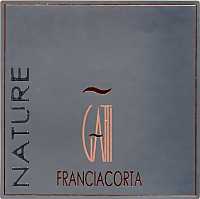
|
|
Franciacorta Nature |
|
| Enrico Gatti (Lombardy, Italy) | |
| Grapes: Chardonnay | |
| Price: € 15.00 | Score: |
| This Franciacorta shows a brilliant golden yellow and nuances of golden yellow, very transparent, fine and persistent perlage. The nose denotes intense, clean, pleasing and refined aromas which start with hints of bread crust, yeast and banana followed by aromas of hawthorn, apple, hazelnut, grapefruit, plum, vanilla, butter and mineral. The mouth has good correspondence to the nose, an effervescent and crisp attack, however balanced by alcohol, good body, intense flavors, agreeable. The finish is persistent with flavors of grapefruit, plum and apple. Part of the base wine ages for 6 months in cask. This Franciacorta ages in bottle on its lees for 24 months. | |
| Food Match: Roasted fish, Stuffed pasta, Broiled crustaceans | |
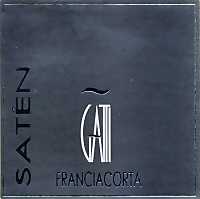
|
|
Franciacorta Satèn 2001 |
|
| Enrico Gatti (Lombardy, Italy) | |
| Grapes: Chardonnay | |
| Price: € 19.00 | Score: |
| This Franciacorta shows a brilliant straw yellow color and nuances of straw yellow, very transparent, fine and persistent perlage. The nose reveals intense, clean, pleasing and refined aromas which start with hints of yeast, grapefruit and bread crust followed by aromas of acacia, banana, hawthorn, pear, vanilla and mineral. The mouth has good correspondence to the nose, an effervescent and crisp attack, however balanced by alcohol, good body, intense flavors, agreeable. The finish is persistent with flavors of banana, grapefruit and pear. This Franciacorta ages in bottle on its lees for 36 months. | |
| Food Match: Pasta and risotto con crustaceans and fish, Sauteed fish and crustaceans | |
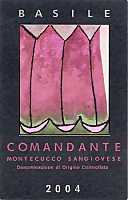
|
|
Montecucco Sangiovese Comandante 2004 |
|
| Basile (Tuscany, Italy) | |
| Grapes: Sangiovese (85%), Merlot (15%) | |
| Price: € 12,00 | Score: |
| The wine shows a brilliant ruby red color and nuances of purple red, moderate transparency. The nose denotes intense, clean and pleasing aromas which start with hints of black cherry and pomegranate followed by aromas of blueberry, blackberry, plum, cyclamen and vanilla. The mouth has good correspondence to the nose, a slightly tannic attack and pleasing crispness, however balanced by alcohol, good body, intense flavors. The finish is persistent with flavors of blueberry and black cherry. This wine ages for 10 months in casks. | |
| Food Match: Broiled meat and barbecue, Sauteed meat with mushrooms, Stuffed pasta | |

|
|
Montefalco Sagrantino Colle Grimaldesco 2002 |
|
| Tabarrini (Umbria, Italy) | |
| Grapes: Sagrantino | |
| Price: € 23.00 | Score: |
| This wine shows an intense ruby red color and nuances of ruby red, moderate transparency. The nose reveals intense, clean and pleasing aromas that start with hints of black cherry and blackberry followed by aromas of plum, blueberry, violet, vanilla, licorice, tobacco, cocoa and pink pepper. The mouth has good correspondence to the nose, a tannic attack and however balanced by alcohol, good body, intense flavors. The finish is persistent with flavors of black cherry, blackberry and plum. This Sagrantino ages for 20 months in cask. | |
| Food Match: Game, Roasted meat, Stewed and braised meat, Hard cheese | |

|
|
Montefalco Sagrantino Passito Colle Grimaldesco 2001 |
|
| Tabarrini (Umbria, Italy) | |
| Grapes: Sagrantino | |
| Price: € 30.00 - 375ml | Score: |
| The wine shows a deep ruby red color and nuances of garnet red, little transparency. The nose reveals personality with intense, clean, pleasing, refined and elegant aromas which start with hints of blackberry, black cherry and prune followed by aromas of dried fig, dried violet, enamel, vanilla, caramel, cocoa, cinnamon, tobacco, tamarind, pink pepper and maces. The mouth has excellent correspondence to the nose, a tannic and sweet attack, pleasing roundness, however balanced by alcohol, full body, intense flavors, very agreeable. The finish is very persistent with long flavors of blackberry, black cherry, prune and tamarind. A very well made wine. This Sagrantino Passito ages for at least 24 months in cask. | |
| Food Match: Confectionery, Hard cheese, Broiled meat | |

|
|
Barbera d'Alba 2003 |
|
| Bruno Rocca (Piedmont, Italy) | |
| Grapes: Barbera | |
| Price: € 20.00 | Score: |
| This Barbera shows an intense ruby red color and nuances of ruby red, little transparency. The nose denotes intense, clean, pleasing, refined and elegant aromas which start with hints of cherry and black currant followed by aromas of blueberry, vanilla, licorice, tobacco, chocolate, leather, mace, eucalyptus and hints of black pepper. The mouth has good correspondence to the nose, a tannic attack and pleasing crispness, however balanced by alcohol, full body, intense flavors, agreeable. The finish is persistent with flavors of cherry, black currant and plum. A well made wine. This Barbera ages for 14-16 months in barrique followed by 6 months of aging in bottle. | |
| Food Match: Game, Roasted meat, Stewed and braised meat, Hard cheese | |

|
|
Barbaresco Rabajà 2002 |
|
| Bruno Rocca (Piedmont, Italy) | |
| Grapes: Nebbiolo | |
| Price: € 37.50 | Score: |
| This Barbaresco shows a brilliant ruby red color and nuances of brick red, moderate transparency. The nose reveals intense, clean, pleasing, refined and elegant aromas which start with hints of cherry and plum followed by aromas of raspberry, violet, rose, vanilla, tobacco, licorice, cocoa, cinnamon, leather and menthol. The mouth has good correspondence to the nose, a tannic attack and pleasing crispness, however balanced by alcohol, full body, intense flavors, agreeable. The finish is persistent with flavors of cherry and plum. A well made wine. This Barbaresco ages for 18 months in cask followed by 12 months of aging in bottle. | |
| Food Match: Game, Roasted meat, Stewed and braised meat, Hard cheese | |
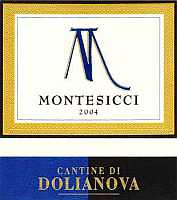
|
|
Montesicci 2004 |
|
| Cantine di Dolianova (Sardinia, Italy) | |
| Grapes: Vermentino (75%), Malvasia (15%), Nasco (10%) | |
| Price: € 12.00 | Score: |
| This wine shows a pale golden yellow color and nuances of straw yellow, very transparent. The nose reveals intense, clean, pleasing and refined aromas which start with hints of peach and almond followed by aromas of broom, hawthorn, apple, pear and plum. The mouth has good correspondence to the nose, a crisp attack and however balanced by alcohol, good body, intense flavors, agreeable. The finish is persistent with flavors of pear, plum and almond. Montesicci ages in steel tanks. | |
| Food Match: Fish and crustaceans appetizers, Pasta and risotto with fish and vegetables | |
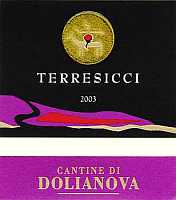
|
|
Terresicci 2003 |
|
| Cantine di Dolianova (Sardinia, Italy) | |
| Grapes: Barbera (85%), Syrah (10%), Montepulciano (5%) | |
| Price: € 25.00 | Score: |
| This wine shows an intense ruby red color and nuances of ruby red, moderate transparency. The nose denotes intense, clean, pleasing and refined aromas that start with hints of cherry and plum followed by aromas of pomegranate, blackberry, black currant, carob, licorice and vanilla. The mouth has good correspondence to the nose, a tannic attack and however balanced by alcohol, good body, intense flavors. The finish is persistent with flavors of cherry, plum and blackberry. Terresicci ages for 12 months in barrique. | |
| Food Match: Roasted meat, Stewed and braised meat with mushrooms, Hard cheese | |
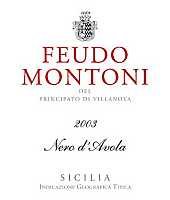
|
|
Nero d'Avola Classico 2003 |
|
| Feudo Montoni (Sicily, Italy) | |
| Grapes: Nero d'Avola | |
| Price: € 12.50 | Score: |
| The wine shows a brilliant ruby red color and nuances of ruby red, moderate transparency. The nose denotes intense, clean and pleasing aromas which start with hints of cherry and plum followed by aromas of blueberry, blackberry, cyclamen, carob and vanilla. The mouth has good correspondence to the nose, a slightly tannic attack and however balanced by alcohol, good body, intense flavors. The finish is persistent with flavors of cherry and plum. This Nero d'Avola ages for 8 months in barrique followed by 4 months of aging in bottle. | |
| Food Match: Broiled meat and barbecue, Stewed meat with mushrooms, Stuffed pasta | |
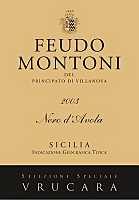
|
|
Nero d'Avola Selezione Speciale Vrucara 2003 |
|
| Feudo Montoni (Sicily, Italy) | |
| Grapes: Nero d'Avola | |
| Price: € 24.00 | Score: |
| The wine shows an intense ruby red color and nuances of garnet red, little transparency. The nose reveals intense, clean, pleasing and refined aromas that start with hints of black cherry and blackberry followed by aromas of blueberry, plum, violet, vanilla, licorice, menthol and cocoa. The mouth has good correspondence to the nose, a slightly tannic attack and good roundness, however balanced by alcohol, good body, intense flavors, agreeable. The finish is persistent with flavors of black cherry, plum and blackberry. This Nero d'Avola ages for 12 months in barrique followed by 6 months of aging in bottle. | |
| Food Match: Broiled meat and barbecue, Roasted meat, Stewed meat, Hard cheese | |
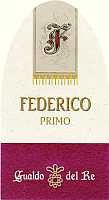
|
|
Val di Cornia Suvereto Cabernet Sauvignon Federico Primo 2002 |
|
| Gualdo Del Re (Tuscany, Italy) | |
| Grapes: Cabernet Sauvignon | |
| Price: € 20.00 | Score: |
| This wine shows an intense ruby red color and nuances of garnet red, little transparency. The nose reveals intense, clean, pleasing, refined and elegant aromas of black cherry, plum and black currant followed by aromas of blueberry, violet, tobacco, vanilla, licorice, cocoa, clove, mace, black pepper and eucalyptus. The mouth has very good correspondence to the nose, a tannic attack and however balanced by alcohol, full body, intense flavors, agreeable. The finish is very persistent with long flavors of black cherry, black currant and plum. A well made wine. Federico Primo ages for 12-14 months in barrique followed by 12 months of aging in bottle. | |
| Food Match: Game, Roasted meat, Stewed and braised meat, Hard cheese | |

|
|
Val di Cornia Suvereto Merlot I'Rennero 2002 |
|
| Gualdo Del Re (Tuscany, Italy) | |
| Grapes: Merlot | |
| Price: € 25.50 | Score: |
| This wine shows an intense ruby red color and nuances of garnet red, little transparency. The nose denotes intense, clean, pleasing, refined and elegant aromas that start with hints of black currant, black cherry and plum followed by aromas of blueberry, violet, tobacco, vanilla, licorice, chocolate, cinnamon, eucalyptus and mace. The mouth has good correspondence to the nose, a tannic attack and pleasing smoothness, however balanced by alcohol, full body, intense, flavors, agreeable. The finish is very persistent with flavors of black cherry, black currant and plum. A well made wine. I'Rennero ages for 12-14 months in barrique followed by an aging of 12 months in bottle. | |
| Food Match: Game, Roasted meat, Stewed and braised meat, Hard cheese | |
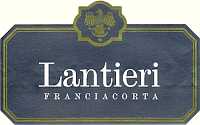
|
|
Franciacorta Brut |
|
| Lantieri de Paratico (Lombardy, Italy) | |
| Grapes: Chardonnay (90%), Pinot Blanc (10%) | |
| Price: € 12.00 | Score: |
| The wine shows a brilliant golden yellow color and nuances of golden yellow, very transparent, fine and persistent perlage. The nose denotes intense, clean, pleasing and refined aromas which start with hints of bread crust, yeast and banana followed by aromas of pineapple, grapefruit, hawthorn, apple, pear, plum and honey. The mouth has good correspondence to the nose, am effervescent and crisp attack, however balanced by alcohol, good body, intense flavors, agreeable. The finish is persistent with flavors of grapefruit, plum and apple. This Franciacorta ages in bottle on its lees for 30 months. | |
| Food Match: Pasta and risotto with fish and crustaceans, Broiled crustaceans and fish | |
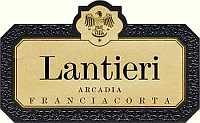
|
|
Franciacorta Arcadia 2001 |
|
| Lantieri de Paratico (Lombardy, Italy) | |
| Grapes: Chardonnay (70%), Pinot Noir (30%) | |
| Price: € 17.00 | Score: |
| This Franciacorta shows a brilliant golden yellow color and nuanced of straw yellow, very transparent, fine and persistent perlage. The nose reveals intense, clean, pleasing and refined aromas which start with hints of hazelnut, bread crust and yeast followed by aromas of banana, hawthorn, grapefruit, apple, plum, vanilla, honey and butter. The mouth has good correspondence to the nose, an effervescent and crisp attack, however balanced by alcohol, good body, intense flavors, agreeable. The finish is persistent with flavors of grapefruit, banana and hazelnut. This Franciacorta ages in bottle on its lees for 48 months. | |
| Food Match: Roasted white meat, Roasted fish, Fish soups | |
Tenute FolonariFolonari is one of the oldest wineries of Italy, which contributed to write the history of Italian wine. Today, Ambrogio and his son Giovanni Folonari are the leaders of a constellation of estates |
|
Folonari is one of the most famous Italian wine companies and one of the oldest of Italy. Today, Ambrogio Folonari and his son Giovanni lead the company - which is in business since the end of 1700's - thanks to their ancestors, who would have never imagined to give a great contribution to write the history of Italian wine. In 1825, Fratelli Folonari S.p.A. started its business, completely owned by the family and with a precise goal: developing, producing and commercializing the best Italian wines all over the world. The Folonari family is in this field since more than 250 years and since then it is one of the most dynamic Italian wine companies. In particular, Ambrogio is one of the main protagonists of the evolution and modernization of the Italian wine market, who successfully adopted new and original paths for the production of high quality wines, giving a great contribution to create “the new frontier” of Italian wine.
The company, modernized by Ambrogio and Giovanni Folonari, is strongly oriented to the current market's demands, combining tradition with innovation. The project of the family is based on the property and leading of many estates, mainly located in Tuscany and in other areas of Italy. The winery takes care of the whole production process: from the production of grapes in their own estates, to the bottling of wine, distributed in many countries of the world. Folonari wines, in fact, are sold in Italy, Austria, Belgium, Canada, China, Denmark, Arab Emirates, Finland, France, Germany, Great Britain, Holland, Japan, Malta, Russia, Singapore, Sweden, Switzerland and USA. Nozzole Estate - 500 hectares, 80 of which cultivated with specialized grape varieties - represents the company's headquarter. The historical estate - acquired by Folonari in 1971 - has very ancient origins, at least seven centuries old. The main grape variety is Sangiovese, however in the vineyards is cultivated Cabernet Sauvignon as well - for the production of the Supertuscan Pareto - and Chardonnay, for the white wine Le Bruniche. Cabreo estates are located in the territory of Greve in Chianti: one of them is located in Panzano village - at 500 meters above sea level, with an area of 25 hectares of vineyards - where selected clones of Chardonnay are being cultivated for the production of Cabreo La Pietra; the other is located in the Cabreo di Zano place, where - in a vineyard of about 46 hectare - are cultivated Sangiovese and Cabernet Sauvignon used for Cabreo il Borgo. Cabreo is an IGT (Indicazione Geografica Tipica, Typical Geographical Indication) and was commercialized in 1985 for the first time with vintage 1982. This wine is the result of a blend of Sangiovese and Cabernet Sauvignon, which, together, exalt both the elegance and sapidity of Sangiovese as well as the roundness and concentration of Cabernet Sauvignon. Cabreo La Pietra, produced for the first time in 1983, is a white wine, which, through the fermentation and refining in wood, is the expression of the Tuscan interpretation of a successful and renowned international style.
TorCalvano di Gracciano Svetoni Estate is located in the area of Gracciano, in the center of the wine area of Montepulciano, in the province of Siena. In the past, the estate was property of the local Mazzucchelli Svetoni family, with an area of 30 hectares, 22 of which cultivated with specialized grape varieties. Here are being cultivated Prugnolo Gentile - the local name for Sangiovese variety - as well as other typical red and innovative grape varieties. The vineyards are located around the big villa with two donjons, where a typical cellar with vaults and oak barrels was built. The remaining vineyards are located in the nearby of the prestigious area of Cervognano. Conti Spalletti Estate is one of the most oldest estates in the area of Chianti Rufina, in the province of Florence. The vineyards are cultivated with specialized grape varieties, covering an area of 25 hectares, in which Sangiovese, Lanaiolo and Colorino varieties are being cultivated. Since 1999, the family began to acquire parts of land in the area of Castagneto Carducci, in the province of Livorno. In 1990, in this area, Bolgheri DOC made a name itself. This area has a very favorable and tempered weather, thanks to the breeze from the Tyrrhenian Sea. The sandy and clayey soils slope towards the sea and proven to have an excellent vocation to exalt the Bordelais blend. In these lands, Cabernet Sauvignon, Cabernet Franc, Merlot and Petit Verdot express their best qualities. Ambrogio and Giovanni Folonari Estates have acquired about 40 hectares, 24 of which destined to vineyards, whereas the remaining are in the process of being planted. A modern wine cellar is about to be built by following the project of Parisian architect Jean-Michel Wilmotte. In the area of Cinigiano, in the province of Grosseto, around the ancient Porrona castle, the Folonari family has acquired about 60 hectares suited to the cultivation of high quality vineyard. In 1999, the planting of the vineyards started with Sangiovese and Syrah varieties. In 2007, will be commercialized Montecucco DOC, the first wine produced in this estate. This is the smallest estate of the family group, covering an area of 20 hectares, of which 9.8 destined to vineyard. La Fuga Estate is located in the commune of Montalcino - whose borders delimit the Brunello DOCG production area - run and managed by the Folonari Family. Novacuzzo is the estate which has recently acquired by Folonari Family. It is located in one of the best areas of Colli Orientali del Friuli, in the province of Udine. Located in a hill, the estate has an area of 50 hectares, of which 40 cultivated with Pinot Gris, Sauvignon Blanc, Tocai Friulano, Ribolla Gialla, Piccolit and the red grape variety Schioppettino.
|
||||||||||||||||||||
|
Score legend Prices are to be considered as indicative. Prices may vary according to the country or the shop where wines are bought |
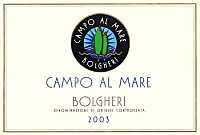
|
|
Bolgheri Campo al Mare 2003 |
|
| Tenute Folonari (Tuscany, Italy) | |
| Grapes: Merlot (60%), Cabernet Sauvignon (20%), Cabernet Franc (20%) | |
| Price: € 16.00 | Score: |
| The wine shows an intense ruby red color and nuances of ruby red, little transparency. The nose reveals intense, clean, pleasing and refined aromas that start with hints of plum and black currant followed by aromas of black cherry, pomegranate, blueberry, cyclamen and vanilla. The mouth has good correspondence to the nose, a slightly tannic attack and however balanced by alcohol, good body, intense flavors. The finish is persistent with flavors of black cherry and plum. This wine ages for 12 months in barrique followed by 3 months of aging in bottle. | |
| Food Match: Broiled meat and barbecue, Stewed meat with mushrooms | |

|
|
Brunello di Montalcino La Fuga 2000 |
|
| Tenute Folonari (Tuscany, Italy) | |
| Grapes: Sangiovese | |
| Price: € 33.00 | Score: |
| This Brunello di Montalcino shows a brilliant ruby red color and nuances of garnet red, little transparency. The nose reveals intense, clean, pleasing and refined aromas which start with hints of black cherry, plum and violet followed by aromas of blueberry, licorice, tobacco, cocoa, cinnamon, vanilla and menthol. The mouth has good correspondence to the nose, a slightly tannic attack and pleasing roundness, however balanced by alcohol, full body, intense flavors. The finish is persistent with flavors of black cherry, plum and blueberry. A well made wine. This Brunello di Montalcino ages for 36 months in cask and for 12 months in bottle. | |
| Food Match: Game, Roasted meat, Braised and stewed meat, Hard cheese | |
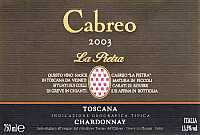
|
|
Cabreo La Pietra 2003 |
|
| Tenute Folonari (Tuscany, Italy) | |
| Grapes: Chardonnay | |
| Price: € 23.00 | Score: |
| This wine shows a brilliant straw yellow color and nuances of straw yellow, very transparent. The nose reveals intense, clean, pleasing, refined and elegant aromas that start with hints of apple, banana and vanilla followed by aromas of pineapple, acacia, hawthorn, pear, grapefruit, plum and hazelnut. The mouth has good correspondence to the nose, a crisp attack and pleasing roundness, however balanced by alcohol, good body, intense flavors, agreeable. The finish is persistent with flavors of banana, pear and pineapple. A well made wine. Cabreo La Pietra ages for 8 months in barrique followed by at least 6 months of aging in bottle. | |
| Food Match: Roasted white meat, Roasted fish, Broiled crustaceans, Stuffed pasta | |
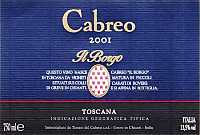
|
|
Cabreo Il Borgo 2001 |
|
| Tenute Folonari (Tuscany, Italy) | |
| Grapes: Sangiovese (70%), Cabernet Sauvignon (30%) | |
| Price: € 30.00 | Score: |
| This wine shows an intense ruby red color and nuances of ruby red, little transparency. The nose reveals intense, clean, pleasing, refined and elegant aromas which start with hints of black cherry, plum and black currant followed by aromas of blueberry, violet, vanilla, tobacco, licorice, leather, pink pepper and menthol. The mouth has good correspondence to the nose, a tannic attack and however balanced by alcohol, full body, intense flavors, agreeable. The finish is persistent with flavors of black cherry, plum and black currant. Cabreo il Borgo ages for 16-18 months in barrique followed by at least 6 months of aging in bottle. | |
| Food Match: Game, Roasted meat, Braised and stewed meat, Hard cheese | |
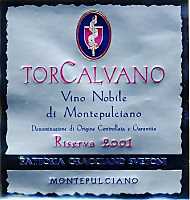
|
|
Vino Nobile di Montepulciano Riserva TorCalvano Gracciano Svetoni 2001 |
|
| Grapes: Sangiovese (90%), Cabernet Sauvignon (10%) | |
| Price: € 19.50 | Score: |
| This wine shows an intense ruby red color and nuances of ruby red, little transparency. The nose reveals intense, clean, pleasing, refined and elegant aromas which start with hints of black cherry, plum and black currant followed by aromas of blackberry, violet, licorice, tobacco, vanilla, pink pepper, chocolate and mace. The mouth has good correspondence to the nose, a tannic attack and however balanced by alcohol, full body, intense flavors, agreeable. The finish is persistent with flavors of black cherry, plum and black currant. A well made wine. This Nobile di Montepulciano ages for 24 months in cask followed by at least 6 months of aging in bottle. | |
| Food Match: Game, Roasted meat, Braised and stewed meat, Hard cheese | |
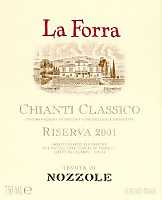
|
|
Chianti Classico Riserva La Forra Tenuta di Nozzole 2001 |
|
| Tenute Folonari (Tuscany, Italy) | |
| Grapes: Sangiovese (90%), Cabernet Sauvignon (10%) | |
| Price: € 19.00 | Score: |
| The wine shows a brilliant ruby red color and nuances of garnet red, little transparency. The nose denotes intense, clean, pleasing, refined and elegant aromas which start with hints of black cherry, blackberry and plum followed by aromas of blueberry, violet, vanilla, licorice, tobacco, cinnamon, chocolate, mace and menthol. The mouth has good correspondence to the nose, a tannic attack and however balanced by alcohol, full body, intense flavors, agreeable. The finish is persistent with flavors of black cherry, blackberry and plum. A well made wine. This Chianti Classico ages for 14-15 months in barrique followed by at least 6 months of aging in bottle. | |
| Food Match: Game, Roasted meat, Braised and stewed meat, Hard cheese | |
| Ambrogio e Giovanni Folonari Tenute - Via di Nozzole, 12 - Loc. Passo dei Pecorai - 50022 Greve in Chianti, Firenze (Italy) - Tel. +39 055 859811 Fax. +39 055 859823 - Winemaker: Marco Cervellera - Established: 2000 - Production: 876.000 bottles - E-Mail: folonari@tenutefolonari.com - WEB: www.tenutefolonari.com |
Cellar Journal |
|
This section is reserved to wine producers who want to publish news and information about their business, to announce new products or just for communicating to customers information and promotions about their products and activity. Send news to be published to our e-mail address.
|
News |
|
In this section are published news and information about events concerning the world of wine and food. Whoever is interested in publishing this kind of information can send us a mail to our address.
|
Vegetarian Cooking and WineMore and more people are getting into vegetarianism, because of the repeating food scandals or as a lifestyle. A diet rich in many foods, which can be perfectly matched to wine |
|
Living healthy is a legitimate aspiration of all of us. However, health should not be considered as a gift of nature, it is something to be obtained and preserved through a rational, healthy and balanced diet. The civilization of consumption has accustomed us to a more sophisticated diet, rich in fats, meats and sugars, which are frequently cause of many diseases. Millions of people in the world - worried for the repeating food scandals or motivated by hygienic, economical, moral or religious reasons - have decided to follow a vegetarian diet. They substituted meat and fish with eggs and dairy products, eat more fibers, cereals, legumes, vegetables and fruit. Eating vegetarian style means trying to feed oneself - by choosing healthy food, not being contaminated from chemical or artificial products - according to nature or, better to say, trying not to be detached from it. Choosing a vegetarian menu does not preclude the matching with a good wine.
|
|
In the history of humanity, there are plenty of examples of vegetarianism. In every era, there have been people who eliminated meat from their diet, both for social or religious reasons, as well as because of their poverty. The term “vegetarianism” was created in the nineteenth century: the word appears in England in 1874 and in France in 1875. In Italy, one of the first cookbooks is dated back to the first decades of the twentieth century. It was “Vegetarian cooking and raw foods naturism”, written by Duke of Salaparuta. The first vegetarian association, the Società Italiana Vegetariana, (Italian Vegetarian Society), known today as Associazione Vegetariana Italiana - AVI (Italian Vegetarian Association), was founded in 1952.
Since ancient times, illustrious men decided to adopt a vegetarian diet because of moral reasons and they also advocated their decisions in their writings. The mathematician and philosopher Pythagoras - as told by his biographer Diogenes and by Ovid in the twentieth book of Metamorphosis - declared that the earth offers a great quantity of wealth, of uncontaminated food, which do not cause bloodshed or death. The writer Plutarch, lived between the first and second century AD, in the essay “On eating meat” - included in “Hygienic Advices” - wrote that «for a piece of meat, man deprives harmless creatures - animals - of the sun, the light, the natural duration of life, to which they have the right for the fact they were born». Leonardo Da Vinci, great painter, architect, sculptor, scientist and thinker of the Renaissance, summarized the ethical principles of vegetarianism, declaring that «the one who does not respect life, does not deserve it». French philosopher of 1700's, Jean Jacques Rousseau, observed the herbivorous animals were less cruel and violent than the omnivorous ones, so he asserted a vegetarian diet would have turned men in less aggressive beings. Other historical figures preferred a vegetarian diet: Scottish economist Adam Smith, Benjamin Franklin, romantic English poet Shelley and Russian writer Tolstoj. Among the most famous ones are mentioned Gandhi, who denied the fallacy that vegetarian diet would turn men into weak, passive and abulic beings.
|
||||||||
|
In all types of vegetarianism there is the common refusal of meat, and, besides this, other kinds of foods can be eliminated from diet as well, including the products of animal origin: eggs, milk and cheese. Therefore, we can distinguish - among the most permissive vegetarian diets - lacto-ovo vegetarianism, which provides for the abstinence from meat and the consumption of milk, dairy products and eggs; ovo vegetarianism, characterized by the consumption of eggs and the abstinence from meat, milk and dairy products; Lacto vegetarianism, characterized by the consumption of milk, dairy products and by the abstinence from meat and eggs. Restrictive vegetarian diets - also called veganism - provide for an exclusively vegetable diet, therefore meat, fish, milk, dairy products, eggs and honey are not allowed. Veganism includes macrobiotics - which provides cereals and beans only - fruitarians - who eat fruit only - and raw foodists, who eat raw vegetables only. The macrobiotic diets can be considered as a permissive vegetarian diets or a vegan diet, because macrobiotics is not based on the elimination of meat, but on the balance between yin and yang foods.
|
|
The base foods of vegetarian diet are: cereals, legumes, dry fruits and oleaginous seeds, fruit and vegetables, dairy products and eggs. Moreover, supplements should considered as well: yeast, wheat germ, sprouts and seaweeds. Condiments are used to prepare the dishes: fat substances, sweetener and other condiments. Concerning drinks, besides water, vegetarians are favorable to the use of fruit, vegetable and herbs juices, tisanes, cereal coffee, decaffeinated tea, green tea, quality wine - sometimes from organic agriculture - beers with low alcohol. Vegetarians are generally contrary to exciting drinks, sweet drinks, syrups and high alcoholic drinks. Moreover, vegetarians do not usually consume refined foods, conserves, deep-frozen food and sugar. Cereals play an important role in vegetarian diet. They are the main dish of the meals, usually associated to cooked and raw vegetables. Vegetarians generally prefer stone milled whole wheat flour, because of the higher content in vitamins and minerals. Among the most consumed cereals, there is wheat - in the form of bread, pasta, crêpe, pizza, custard pies - as well as corn and rice. Macrobiotics prefer consuming this latter one, although they also like eating wheat, millet, barley, buckwheat, rye, corn, oat and spelt. These cereals are often bought in grains and used for the preparation of dishes with vegetables, cereals, legumes or seaweeds. Some people have rice in the morning, for breakfast. Legumes - excluded by some vegetarians - are part of the macrobiotic diet, characterized by beans and seaweeds. The most used legumes are lentils, chickpeas, red beans or azuki, soy - in form of germs, seeds or flour - and dwarf beans. Tofu, a derivative of soybeans, broiled or used as a condiments, is very consumed. It is frequently served with soy sauce, tamari or shoyu, generally used as a substitute for salt. Another food derived from fermented soy is tempeh - rich in iron, proteins, vitamin B12 - a good surrogate of meat which is served in slices and fried. Among the foods consumed by vegetarians, are also included seitan - gluten of wheat - used for sauces, condiments or cooked on the griddle. Bulghur is very good, too - it is made with sprouted hard wheat, precooked, dried and milled - used to make tabuleh, although it is also good served cold, in salads or cooked with vegetables. It is also very good for making little balls or vegetable stuffings, mixed with eggs, onion and cheese. Among the most used oleaginous seeds by vegetarians, are mentioned nuts, peanuts, pistachios, almonds, sunflower seeds and sesame. Dried fruits include raisin, apricots, plums, dates, figs and bananas. Seaweeds - especially consumed by macrobiotics - are used in addition to soups or salads. Germs of different kinds, soy or Alpha Alpha germs, are generally used in salads. The natural flavors added to raw vegetables, cooked dishes as well as to cakes, are many. The most common herbs are laurel, thyme, rosemary, parsley and marjoram. Among the most common spices are mentioned curry, chilly pepper, cloves, coriander, ginger, curcuma, paprika, saffron, cumin, cinnamon and nutmeg. Moreover, it should be remembered vegetarian cooking makes use of garlic, onion, shallot, soy sauces and other condiments such as yeast, wheat germ, which are particular important as supplements. As a sweetener, in place of refined sugar, vegetarians use cane sugar, honey and raisin. Fruit is highly consumed by vegetarians - cooked, raw or dried - on the contrary, macrobiotics do not eat them much. Many kinds of fruit - such as citrus fruits - are forbidden by macrobiotics; fruit juices are not advised, too. Vegetarians and macrobiotics avoid sugar and sugared foods - such as drinks, cakes and marmalades - because they are considered bad for the health or useless. Stimulants are excluded from the diet, too. Some also avoid coffee and even chocolate, the latter because contains theobromine, a natural stimulant. In cakes, chocolate is often substituted by carobs. Macrobiotics frequently avoid mint, because it is considered as a stimulating drink. White sugar, polished rice, white bread, finely sifted flours, refined oils and every industrial food made with these ingredients, are banished from vegetarian diet. The choice of oil is very important: olive oil, carthame oil, sesame oil or peanut oil are used only in case they are of primary pressing - preferably cold pressing - without the use of any solvent. Vegetarian diet does not approve conserves and, even less, deep-frozen foods or frozen foods. This is because many vegetarians believe industrial processing of preservation, to which the food is subjected to, is bad for quality as well as for their adulteration. For a better appreciation of the vegetarian cooking and in order to make a healthy, tasty and light cooking, it is very important the way foods are cooked as well as the appropriate matching with wines. In particular, the right processing and appropriate way of cooking foods, greatly influence taste, nutritional values, digestibility and the time required for digestion. It is always very important to keep the nutritional principles of foods, including vitamin and mineral salts, essential elements for a correct diet.
|
||||
|
Despite the consumption of wine is usually excluded by the different types of vegetarianism, there are many - who decide to exclusively have food of a vegetable origin - who tolerate and appreciate the consumption of the beverage of Bacchus and the possibility to match it with food. Because vegetarian diet does not allow the consumption of meat and other foods of animal origin, vegetarian cooking is usually - and wrongly - considered simple and not tasty, characterized by light and delicate dishes. This is false, because legumes - one of the main ingredients of vegetarian diet, in particular beans - allow the preparation of nutrient and tasty dishes. The same is valid for cereals - including pasta - with which can be made very tasty soups and dishes. In the wide variety of ingredients typical in vegetarian diet, the matching with wine is rich and interesting as well. Knowing the organoleptic qualities of the ingredients used in vegetarian cooking is essential in order to make the right food matching, a factor which is in any case indispensable no matter the type of cooking and its ingredients. Vegetables are, first of all, rich in minerals, so they usually have - without the adding of other condiments - a basically sapid taste, especially when consumed raw. For this reason they require the matching with a pretty round wine, and this is also a good choice for matching the slightly bitter taste of some vegetables. Vegetables - as well as cereals and legumes - are also characterized by a basically sweet taste, a quality requiring the matching with crisp wines having a good acidity. White wines, rose wines - as well as many sparkling wines, even produced with the classic method - can be therefore matched with vegetables and legumes. Even red wine can be matched with vegetarian cooking, in particular with legumes, rich in proteins - such as beans and soybeans - especially when the preparation provides for a long cooking and robust condiments. In such cases, it is possible to choose a red wine with a good body, with a pretty high content in alcohol and moderate astringency, in order to balance succulence. Pasta dishes, with vegetable condiments, can be matched with non tannic red wines, such as Pinot Noir and Grignolino. In case tomato is present in the condiment, it is best to choose a white or red wine with a good roundness. Fruit is the most typical ingredient in the vegetarian desserts. In case desserts are prepared with fresh fruit, a good matching is represented by sweet sparkling wines, such as Asti and Brachetto, whereas desserts with dried fruits can be exalted with the matching with a sweet wine or a raisin wine.
|
The Culture of TeaProduced by the infusion in water of its small and aromatic green leaves, tea plays an important role in the customs and in the culture of many countries of the world |
|
Since men discovered the infusion of the small tea leaves could give an aromatic and healthy beverage, they never stopped using it. Tea, one of the most ancient beverages known, goes beyond this simple definition. In past times, its leaves were used as money as well as a good for paying imperial taxes in ancient China, always playing an essential and important role in trading. Tea has also been fundamental for the birth of United States of America, as it was the cause of the independence risings against England. On December 16th, 1773, in Boston, some members of the Sons of Liberty - dressed as Mohawk native Indians - assaulted three ships of the British East India Company and threw the precious load of tea into the sea. It was a form of protest against the Tea Act - emanated by the mother country England - which imposed taxes on tea therefore causing malcontent in people. This episode is known as the Boston Tea Party. The history of tea has its origin in very ancient times. Some documents date back the “discovery” of this precious beverage in 2737 BC, when the famous emperor Sheng Nung - who was sitting at the feet of a tea tree - was waiting for its water to boil. The ancient custom of boiling and drinking warm water was very common in China, both because it was believed the water had a better quenching and healthy effect, as well as because of hygienic reasons. It is told some tea leaves fell from the tree and landed in the emperor's cup. When he drunk from his cup, the emperor found that water to be excellent: this is how the first tea infusion was born. Despite there are no reliable documents about this event - frequently mentioned as a legend instead of a real event - the tea plant is known in China for more than 3,000 years. In fact, the first written documents in which the term tea is mentioned - referred as the infusion of the leaves of the homonymous plant - are dated back to this period.
|
|
Today tea represents in China a fundamental cultural element - one of those factors which also determines identity - a role which has been played for thousands of years in the country. Considered by Chinese more than a national beverage, tea is in fact frequently drunk as a healthy beverage, capable of soothing or preventing some diseases. Healthy benefits of tea are in fact mentioned in many medicine book of ancient China, and even Huang Di - the legendary Yellow Emperor - wrote about healthy effects of tea on its Nei Jing Su Wen, the book of inner medicine. The consumption of tea in China soon become a social custom, so important that was even created an art who set the principles for its brewing. The art of Chinese tea will be strongly influenced by one of the most important figures of the history of this beverage - Lu Yu - who in 760 AD wrote his renowned book Cha Jing, that is the Book of Tea. Cha Jing is the first book of the history completely dedicated to tea, in which - and for the first time - every aspect of the beverage is thoroughly explained, from cultivation of the plant to the processing, as well as the rules for brewing and poems and aphorisms about tea.
The work of Lu Yu is still today considered as an important reference for every tea enthusiast. His figure, his thoughts and his lifestyle - completely dedicated to the cult of tea and to the harmonious relationship of man with nature - have been so important as to consider Lu Yu as the god of tea. Soon after, everywhere in China were established the so called tea houses, public places where people gathered together, talking and drinking tea. Tea houses are still today very common in the country and represent an important reference for social life. In China the consumption of tea is almost completely about green tea, of which exists hundreds of different varieties, each having its aromas, flavors and properties. In China are also appreciated the so called Hua Cha - that is tea aromatized with flower petals, such as jasmine and chrysanthemums - as well as semi-fermented teas. China is the country having the most ancient tea culture - the plant of tea, the Camellia Sinensis is in fact from China - and the way of preparing the infusion has changed in the course of the centuries. Today, just like in most of the countries in the world, tea in China is prepared by the infusion of the leaves in hot water. Among the most ancient civilization of the world, China has played a fundamental role in the cultural development of other eastern countries, also introducing the culture and the consumption of tea. Japan, Taiwan, Korea and Vietnam - countries in which the consumption of tea represents an important social custom - have received from China the culture for this beverage. Of them, Japan certainly is the country which has been amazed by the charm of tea, as to create a rigid and formal ceremony, the famous Cha No Yu, literally hot water for tea. In Cha No Yu, the preparation of tea gets high dignity and every movement, instant, object and the place where it is being celebrated in, must scrupulously follow a precise ritual and form, both by the one who is offering and making tea, as well as by guests. Indeed, behind the rigid rules of the Cha No Yu, it is looked for the expression of the relationship of men with himself, a moment in which it is being exalted the dignity and the respect for oneself and for the others, a precise searching and exaltation of the beauty and hospitality. The fundamental sense of Cha No Yu can be summarized with an episode in which Sen No Rikyu, the greatest and most important Cha No Yu master, was protagonist. Lived in Japan during the 1500's, the thought of Sen No Rikyu has determined both the spreading of the culture and consumption of tea in Japan, as well as of the suggestive ceremony. It is told Sen No Rikyu was invited by a farmer in his house for a tea. The master accepted and brought with him some disciples. The farmer - excited for the honor of having the great master in his house - prepared the tea with pretty clumsy movements in front of Rikyu, who stayed impassive. When they were on their way home, the disciples - scoffing at the poor farmer - told the master how that humble man could invite the great master and offered the tea in such a way. Sen No Rikyu replied that man performed the Cha No Yu impeccably. To the astonishment of his disciples, the master said that man offered a tea to him with sincerity and with his heart, therefore he made no mistake. The consumption of tea in Japan is not exclusively associated to the ritual ceremony of Cha No Yu. The beverage is consumed by Japanese even in less formal moments and the consumption is almost exclusively about green tea. Another eastern country in which tea has an important social role is Korea. Tea was introduced in the country in the sixth or seventh century AD by some Buddhist monks coming back from China. Even in Korea - just like in China and in Japan - is celebrated a formal ceremony for the preparation and the service of tea. In Korea the consumption of tea is almost exclusively about green tea and the beverage is part of the customs and culture of the country, whose people drink it - usually with no ritual ceremonies - in different moments of the day. Even in Taiwan the culture of tea is a very important social expression and the consumption of the beverage is very common in the country. Here it is mainly produced and consumed semi-fermented tea - the so called Wu Long Cha, literally black dragon tea - however green tea is pretty common as well. Another important country for the culture of tea is India. As opposed to other eastern countries - in which it is being cultivated the Camellia Sinensis variety - here it is being cultivated the local Camellia Assamica variety. It is from this variety which is produced most of the black tea exported and consumed in the European countries and in North America. The consumption of tea in India is very common, a custom which is mainly represented by black tea and which is spread all over the country, as well as in the nearby island of Sri Lanka, another important tea producer. In India tea is mainly prepared by the simple infusion of the leaves in water, however it is pretty common the custom of adding seed and spices in order to aromatize the beverage, as well as preparing the infusion of the leaves in milk instead of water.
|
||||||||||||
|
Despite in Europe and in western countries the culture of tea has strongly been influenced by England, tea arrives for the first time in the old continent with a Dutch ship. It was in fact in 1610 that for the first time the green and aromatic small leaves of tea arrived in Europe, without having any success, though. It was only around 1650 tea arrived in England - at those times strong consumer of coffee - and which slowly become, also thanks to its spreading among noble classes, the national beverage. Before arriving in Europe, tea was already known in the countries of the middle east, whose people are still particularly devoted to the consumption of this beverage. In fact, there are many countries of the middle east in which green tea in widely consumed, frequently aromatized with mint leaves and very sweetened, a custom which is also common in the countries of northern Africa. Among the countries of northern Africa, it is pretty singular the method used in Tunisia for making tea, similar to the countries of Arab culture - that is very sweet and aromatized with mint leaves - to which are also added pine nuts. Famous consumer of tea, the Tuareg people have for this beverage a particular predilection. Tea is generally served at the end of every meal, in particular after the evening meal. Tuareg are used to consume green tea - frequently aromatized with mint leaves - which they boil for three times in order to obtain a more and more delicate beverage. At the end of every boiling, tea is alternatively poured in two carafes, by keeping them well apart in order to form abundant froth. Tuareg are used to say the first infusion - strong and dark - is hard like death, the second one is strong like life and the third one - more delicate and light - sweet like love. In Arab countries it is common to offer tea to the guests and the beverage is also consumed during meals, whereas in bazaars, merchants are used to offer tea to their clients, during the long and characteristic negotiation preceding the selling. The culture of tea is very common and strong in Russia too. Tea arrived for the first time in the country in 1618, when Zar Alexis received as a gift the leaves from the Emperor of China. Later, with the increasing of consumptions and its spreading, tea became a precious good of trading. Zarine Elisabeth even organized long expeditions of caravans from China in order to lay in supplies of the precious tea leaves. In Russia the consumption of tea is still today an important social aspect: everywhere in the country are found Chai-Naya, that is tea houses, just like in China. The consumption of tea in Russia is associated to the characteristic samovar - a particular boiler made of copper or brass of the seventeenth century - to whose top is found a teapot containing very concentrated tea. About a quarter of tea is poured in the cup - most frequently a glass with silver handles - which is then filled with hot water drawn off from samovar's tap. The typical way of drinking tea consists in putting a sugar lump or a teaspoon of jam in the mouth, followed by a sip of tea, to which can also be added a slice of lemon. England is the country that more than every other has influenced the culture of tea in all the other European countries. Typical of the English culture are in fact the custom of adding milk to tea as well as the five o'clock tea, a custom which originated from English noble classes, still today considered as a fundamental rule by the ones who like having tea the English way. The consumption of tea in England is almost exclusively about black tea, a custom that will influence the spreading of tea in all the other countries of Europe, as well as the way of brewing the beverage. Despite in England there is no formal tea ceremony - as opposed to eastern countries - the “rite” of five o'clock tea however has rules for the making of tea, for foods to be served with the beverage as well as the behavior of guests. Tea is the most ancient beverage - after water, of course - and its importance has been such that it contributed to the creation of rites, ceremonies and cultures in every countries in which it has been introduced. Despite social and cultural differences, in every country of the world, tea always represents a peaceful and tranquil occasion, both to oneself and to the others, a way to take care of oneself and to escape from the frenzy of modern times, which man stubbornly forces himself to. This is the magic of the small and aromatic tea leaves, too.
|
AquavitaeReview of Grappa, Distillates and Brandy |
|
|
| Distillates are rated according to DiWineTaste's evaluation method. Please see score legend in the "Wines of the Month" section. |
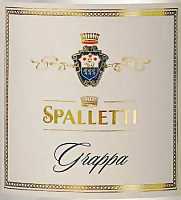
|
|
Grappa Spalletti |
|
| Tenute Folonari (Tuscany, Italy) | |
| (Distiller: Distillerie Bonollo) | |
| Raw matter: Pomace of Sangiovese | |
| Price: € 6.50 - 70cl | Score: |
| This grappa is colorless, limpid and crystalline. The nose denotes intense, clean and pleasing aromas of plum, black cherry, honey, hazelnut and licorice, with almost imperceptible alcohol pungency. In the mouth has intense flavors with perceptible alcohol pungency, good correspondence to the nose, balanced sweet hint. The finish is persistent with flavors of plum and licorice. This grappa is distilled with discontinuous steam alembic still in copper boilers. Alcohol 40%. | |

|
|
Grappa di TorCalvano Fattoria di Gracciano Svetoni |
|
| Tenute Folonari (Tuscany, Italy) | |
| (Distiller: Distillerie Berta) | |
| Raw matter: Pomace of Sangiovese | |
| Price: € 19.50 - 50cl | Score: |
| The grappa is colorless, limpid and crystalline. The nose reveals intense, clean and pleasing aromas of plum, black cherry, violet, licorice and anise, with almost imperceptible alcohol pungency. In the mouth has intense flavors with perceptible alcohol pungency, good correspondence to the nose, balanced sweet hint. The finish is persistent with flavors of plum and black cherry. This grappa is distilled with discontinuous steam alembic still in copper boilers. Alcohol 43%. | |

|
|
Grappa Cabreo Il Borgo |
|
| Tenute Folonari (Tuscany, Italy) | |
| (Distiller: Distillerie Berta) | |
| Raw matter: Pomace of Cabernet Sauvignon and Sangiovese | |
| Price: € 19.50 - 50cl | Score: |
| This grappa is colorless, limpid and crystalline. The nose reveals intense, clean, pleasing and refined aromas of black cherry, blueberry, plum, raspberry and cyclamen, with almost imperceptible alcohol pungency. In the mouth has intense flavors with perceptible alcohol pungency, good correspondence to the nose, balanced sweet hints. The finish is persistent with flavors of black cherry, plum and raspberry. This grappa is distilled with discontinuous steam alembic still in copper boilers. Alcohol 43%. | |

|
|
Grappa La Morbida |
|
| Roner (Alto Adige, Italy) | |
| Raw matter: Pomace of Moscato Bianco and Chardonnay | |
| Price: € 13.10 - 70cl | Score: |
| This grappa is colorless, limpid and crystalline. The nose reveals intense, clean, pleasing and refined aromas of pear, apple, banana, broom, white rose and honey, with almost imperceptible alcohol pungency. In the mouth has intense flavors, perceptible alcohol pungency which tends to dissolve rapidly, good correspondence to the nose, pleasing smoothness and balanced sweet hint. The finish is persistent with flavors of pear, peach and honey. This grappa is produced with double distillation in bainmarie alembic stills. Alcohol 40%. | |
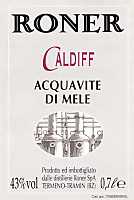
|
|
Acquavite di Mele Caldiff Privat 2004 |
|
| Roner (Alto Adige, Italy) | |
| Raw matter: Gravensteiner Apples | |
| Price: € 18.95 - 70cl | Score: |
| This distillate shows an intense amber yellow color, limpid and crystalline. The nose reveals intense, clean, pleasing, refined and elegant aromas of apple, vanilla, caramel, tobacco, licorice, dried fig, honey and hazelnut, with almost imperceptible alcohol pungency. In the mouth is elegant with intense flavors, perceptible alcohol pungency which dissolves rapidly, excellent correspondence to the nose, pleasing smoothness and balanced sweet hint, very agreeable. The finish is very persistent with long flavors of apple, dried fig, licorice and honey. A very well made distillate. This fruit brandy is produced with double distillation in bainmarie alembic stills and ages for 2 years in barrique. Alcohol 43%. | |
Wine Parade |
|
|
| The best 15 wines according to DiWineTaste's readers. To express your best three wines send us an E-mail or fill in the form available at our WEB site. |
| Rank | Wine, Producer | |
|---|---|---|
| 1 |
| Aglianico del Vulture La Firma 2002, Cantine del Notaio (Italy) |
| 2 |
| Amarone della Valpolicella Classico 1998, Santa Sofia (Italy) |
| 3 |
| Palazzo della Torre 2000, Allegrini (Italy) |
| 4 |
| Trento Talento Brut Riserva Methius 1998, Dorigati (Italy) |
| 5 |
| Colli Orientali del Friuli Rosazzo Bianco Terre Alte 2002, Livio Felluga (Italy) |
| 6 |
| Montepulciano d'Abruzzo Riparosso 2001, Illuminati (Italy) |
| 7 |
| Riesling Central Otago 2004, Felton Road (New Zealand) |
| 8 |
| Chablis Grand Cru Les Clos 2002, Domaine Billaud-Simon (France) |
| 9 |
| Brunello di Montalcino 1999, Castello Banfi (Italy) |
| 10 |
| Riesling Cuvée Frédéric Emile 1999, Maison Trimbach (France) |
| 11 |
| Amarone della Valpolicella Classico 2000, Zenato (Italy) |
| 12 |
| Harmonium 2001, Firriato (Italy) |
| 13 |
| Wine Obsession 2001, Vignamaggio (Italy) |
| 14 |
| Rêve 2001, Velenosi Ercole (Italy) |
| 15 |
| Edizione Cinque Autoctoni 2001, Farnese (Italy) |
| |||||||
Privacy Policy | |||||||


| Copyright © 2002-2024 Antonello Biancalana, DiWineTaste - All rights reserved |
| All rights reserved under international copyright conventions. No part of this publication and of this WEB site may be
reproduced or utilized in any form or by any means, electronic or mechanical, without permission in writing from DiWineTaste. |